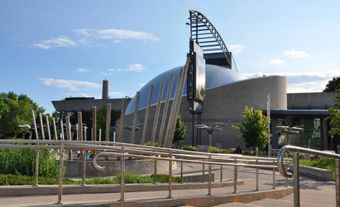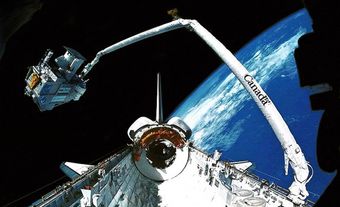Canada is home to more than 40 science centres, planetariums, children's museums and related institutions that have been established to advance scientific literacy by making science learning fun and accessible.

Overview
Science centres are referred to as informal learning environments since they are free of the constraints imposed by traditional classroom settings. They encourage visitors to explore a wide array of stimulating and thought-provoking participatory exhibits on their own terms, based on personal preferences, learning styles and interests.
The Canadian Association of Science Centres (formerly the Canadian Council of Science Centres) was founded in 1985 to create a country-wide network to promote the interests and concerns of the growing number of science centres in Canada. Most science centres offer extensive outreach programs for students and teachers in their regions. School programs provide opportunities for students to explore science concepts and make real-world connections that make science learning back in the classroom more exciting and meaningful. Canadian science centres attract more than 10 million visitors each year.
Specialized programming includes the Super Science Club operated by Vancouver's Science World. This initiative offers after-school science programs to more than 950 at risk students in grades 1–7. Other programs are designed to motivate teenage students to consider careers in science and technology, with a special emphasis on encouraging more female student participation in this sector.
Professional development programs encourage local educators to update their knowledge about science topics taught in the classroom, discuss the latest provincial curriculum connections and engage in hands-on workshops about the latest innovations in science teaching.
History
While science museums that feature static displays of scientific and technological objects have existed for many years, science centres are a contemporary phenomenon aimed at making science subjects more accessible to the general public. The first to succeed in building participatory exhibits were German industrialists at the Deutsches Museum in Munich in 1906. Later, other museums of the history of science (e.g., in London, Chicago, Philadelphia, Boston) added some working exhibits to their historical artifacts.
Real progress in science centre design was spurred on by demands for educational reform arising from the widespread social ferment of the 1960s, coupled with concerns about security and economic threats created by the Cold War, the space race and the emerging industrial prowess of nations such as Japan. Such concerns pushed Western nations to support educational reform and rethink how science was taught. New school science curricula emerged that emphasized student-centred, hands-on learning.
Only after 1960 did the Philips Company in Amsterdam, Frank Oppenheimer in San Francisco and the Ontario government in Toronto establish museums devoted predominantly to experiments in modern science rather than to the display of historical objects. Another pioneer in this field was Seattle's Pacific Science Center, which began as the United States Science Pavilion during the 1962 Seattle World's Fair.
Regional Centres
Central Canada
Ontario
Designed by architect Raymond Moriyama, the Ontario Science Centre in Toronto’s Don Valley became the first such facility in Canada when it opened in 1969. Created as a Centennial project, the centre's official name is the Centennial Centre of Science and Technology.
The Ontario government founded the Ontario Science Centre as a museum of the history of technology but, when it was discovered that historical exhibits of the highest quality were almost unobtainable, the Cabinet ordered the centre to abandon its traditional objectives and to build working exhibits. Since then, exhibits have included a Chinese science exhibit (copies of which were later sold to China) and many IMAX presentations, such as Everest. Ontario Science Centre exhibits have been sold to numerous other countries as well. The centre has welcomed more than 54 million visitors since its opening, and in 2006 it was the most visited cultural attraction in Canada.
To maintain visitor interest and their image as centres of innovation, science centres continually reinvent their exhibit offerings and programming for the general public and educators. Since 2003, the Ontario Science Centre has transformed over 60 per cent of its public space. KidSpark, the hands-on space for children under eight years of age, doubled in size by 2005 to accommodate increased demand. Completed in 2007, the centre’s $47.5 million “Agents of Change” project revolutionized its indoor and outdoor spaces with the creation of the Weston Family Innovation Centre, the outdoor TELUSCAPE plaza and three permanent art installations — the FUNtain, Cloud and Lotic Meander.
In 2000, the Ontario Science Centre opened Science Express in the heart of the Niagara Falls' tourism district. The facility featured more than 20 replicas of the Ontario Science Centre's most popular hands-on, interactive outreach exhibits.
In Sudbury, Inco and Falconbridge Mines, as well as the Ontario government and many citizens, made possible the renovation of a working mine and have built a pavilion for a science centre, Science North, at a cost of $15 million. The centre, designed by Raymond Moriyama, opened in May 1984. The science centre has an annual operating budget in excess of $14 million. Dr. David Pearson, professor of earth sciences at Laurentian University, was project director and then founding director of this popular northern Ontario attraction. In 2000, he was awarded the Ward Neale Medal by the Geological Association of Canada for his contribution to public awareness of the geosciences in Canada.
Science North
Science North, Sudbury, Ontario, 26 June 2007.
(Photo by Steven Miric/Construction Photography/Avalon/Getty Images)
Quebec
In many cities across the country, venerable landmark heritage settings and structures have been redeveloped to house science centres that feature the latest scientific and technological gadgetry. In 1987, Montreal's first EXPOTEC (interactive science exhibition) opened in a converted hangar on the historic King Edward Pier in the Old Port of Montreal (Old Port district). More than a decade later, the city's science centre was opened to the public in the same location. In 2002, it was renamed the Montréal Science Centre. The centre is managed by the Old Port of Montréal Corporation, a crown corporation governed by Canada Lands Company Ltd.
Atlantic Canada
In Fredericton, Science East, New Brunswick's only hands-on science centre, opened in 1999. The facility is housed in a magnificent and sturdy 19th-century granite building that once served as the York County Gaol (jail). The centre also offers province-wide outreach programs in both official languages.
Downtown Halifax is home to the Discovery Centre, which opened its doors to the public in 1990. The centre houses more than 80 permanent hands-on exhibits on science and technology, a state-of-the-art digital planetarium, high-definition films and live science demonstrations. The Discovery Centre also provides science programs for all ages including an extensive outreach program featuring educational demonstrations and workshops to students across Nova Scotia.
The Newfoundland & Labrador Science Centre was housed in the Murray Premises in St. John's from 1997 to 2008. Despite the closure of the facility, the organization continues to operate province-wide outreach programs such as "Science to Go," which combines live video conferencing sessions with classroom workshops.
The North
Located in Watson Lake, Yukon, the Northern Lights Space and Science Centre officially opened to the public in 1997. The centre offers displays and interactive exhibits devoted to space research, remote sensing and the study of the northern lights (aurora borealis). Many of the exhibits were designed by the National Museum of Science and Technology. The centre's space theatre features the Spitz SciDome HD system, powered by Starry Night (the first in Canada), and advanced multimedia production capabilities.
Western Canada
British Columbia
After seven years in a temporary downtown location, Vancouver's Arts, Sciences and Technology Centre was renamed Science World (formerly TELUS World of Science) when it moved into the renovated EXPO Centre, a 1986 World's Fair legacy building, in 1989. Designed by Bruno Freschi, the glistening geodesic dome sits at the edge of the False Creek neighbourhood and has become a civic landmark.
Geodesic Dome of Science World
False Creek and geodesic dome of Science World, Vancouver, British Columbia, 31 May 2012.
(Kevin van der Leek/Getty Images)
The facility spans over 132,000 sq. ft. and has a total exhibit area of over 70,000 sq. ft. The centre has a 400-seat OMNIMAX theatre, a science theatre and five permanent galleries, the largest of which is the Eureka! Gallery, a high-energy exhibition space that explores the themes of water, light and motion. Further renovations in 2012–13 included the development of the colourful Ken Spencer Science Park, which focuses on themes of environmental sustainability.
Alberta
In Alberta, the provincial government, the City of Edmonton and private donors teamed up to fund the construction of the Edmonton Space Sciences Centre. Designed by Douglas J. Cardinal, this striking Edmonton landmark located in Coronation Park opened in 1984. Zeiss Jena produced the star projector for the Margaret Zeidler Star Theatre, Edmonton’s only planetarium. The centre was reborn as the Odyssium after a $14 million expansion and renovation in 2001. In 2004, the centre celebrated its 20th anniversary with an exciting lineup of special shows and programs. In April of that year, in conjunction with the Coral Reef Adventure and building on their Brightest Minds Program, the centre hosted a special visit by world-renowned ocean explorer Jean-Michel Cousteau, son of the legendary Jacques Cousteau.
In 2005, the centre was renamed the TELUS World of Science - Edmonton. The city-owned facility is operated by a non-profit society and in 2023 it welcomed 582,858 visitors. It offers approximately 124,430 sq. ft. of public space, which includes the 16,000 sq. ft. feature exhibition hall (for travelling exhibits), and five galleries devoted to interactive science and technology installations. Their Discoveryland early childhood development gallery is designed to spark the imagination of visitors 8 years and under. In December 2013, the renovated IMAX Theatre re-opened with new 3D Digital IMAX Xenon Projectors (see IMAX Systems Corporation).
With assistance from the Royal Astronomical Society of Canada (Edmonton Centre), the adjacent observatory has installed a Meade 16" LX200 telescope, which is open for public viewing without charge. In 2023, the centre has reported 35,361 annual members and more than 88,655 student participants in their popular school programs.
TELUS Spark (formerly the TELUS World of Science – Calgary) hosts more than 300,000 visitors annually. In response to its growing popularity, the centre constructed a new $160 million facility on a six-hectare remediated brownfield site just north of the Calgary Zoo (see Calgary). The federal, provincial and municipal governments each contributed $40 million for the project.
Opened on 29 October 2011, TELUS Spark was Canada’s first purpose-built science centre in over 25 years and incorporates the latest “green” technologies. The 153,000sq.ft. complex offers over 150 exhibits, five science galleries, an enhanced Creative Kids Museum, a Feature Gallery, which hosts travelling exhibitions, a Learning Centre, a 164‐seat Presentation Theatre and a 10,000sq.ft. atrium. In 2012, TELUS Spark opened its 245-seat HD Digital Dome Theatre featuring Canada’s first SXRD projectors. The new Digital Media Studio was installed within the dome theatre later the same year. The outdoor park dubbed the Brainasium, which encourages children to explore science through play, opened in the summer of 2014.
In 2013, the centre welcomed over 350,000 visitors, including 67,000 students who participated in TELUS Spark’s more than 40 unique school program and exhibit experiences. In the same year, Telus Spark launched the innovative “Direct From the Operating Room” program, which has connected hundreds of high school students to live knee replacement surgeries performed in a local hospital. Students are provided with close up, guided views of the surgical procedures as they happen and are able to access the operating surgical team through a live question and answer interface.
Saskatchewan
In Regina, the Saskatchewan Science Centre is housed in the former city power plant building, a landmark on Wascana Lake since 1914. The centre, which celebrated its 20th anniversary in 2009, features an IMAX theatre and more than 150 hands-on educational exhibits, games and activities on three levels. “The Science of Hockey” exhibit allows visitors to test their reaction times and take slapshots at a virtual goalie. The centre also showcases scientific discoveries by people from the province and technological applications designed to meet Saskatchewan’s unique needs.
Manitoba
In Winnipeg, the Manitoba Museum of Man and Nature and the Manitoba Planetarium were incorporated 1965. The museum, later renamed the Manitoba Museum, opened “Touch the Universe” in 1986. Following the example of earlier interactive science centres, the museum’s “Touch the Universe” gallery encouraged visitors to explore physical science through the five senses. In the 2000s, “Touch the Universe” was replaced by the “Science Gallery,” which includes several hands-on exhibits.
Children's Museums
Designed for younger audiences, science-based children's museums are the fastest growing category of museum in North America. The London Children's Museum, which opened in 1975, was Canada's first interactive educational centre (see London). Their programs and exhibits focus on the educational and social development of children from infancy to age nine. The museum has three floors full of interactive exhibits, activities and programs that encourage children and adult caregivers to play and learn together.
The museum's 1,500 sq. ft. My Arctic Discovery gallery, which opened in 2011, is designed to inspire and educate visitors about Canada's Arctic environment, culture and heritage. The museum is in the process of constructing and moving to a brand new facility to better serve younger residents of the London region.
The Children's Museum of Waterloo Region, which began operation in 2003, offered kinetic experiences such as the Shadow Play exhibit in which children view their multi-coloured shadows as they dance and move about. Elsewhere, art and (bio-) technology are combined in a vertical garden that naturally cleans and cools the Museum's air. In 2010, the facility was renamed THEMUSEUM, and currently offers five floors of interactive exhibits and programs for visitors of all ages. (See also Kitchener-Waterloo.)
Opened in 2006, Calgary’s Creative Kids Museum is a popular component of the new TELUS Spark Science Centre complex. It offers hands-on, sensory-rich activities designed for children under nine.
The Canadian Children's Museum, which was established in 1989, is part of the Canadian Museum of History facility in Gatineau, Quebec. The Canadian Children's Museum has expanded in stages to meet growing demand and currently occupies approximately 87,000 sq. ft. of interior and exterior space. The centre offers interactive experiences with artifacts, props and other materials within a diverse cultural context.
Other children's museums have been established in Hamilton, Laval, Niagara Falls and Winnipeg. Annual attendance at Canadian children's museums ranges from 126,000 to 540,000 visitors per year.

 Share on Facebook
Share on Facebook Share on X
Share on X Share by Email
Share by Email Share on Google Classroom
Share on Google Classroom







